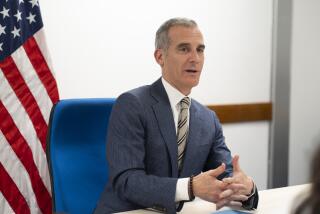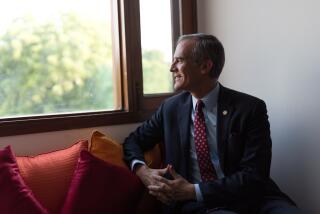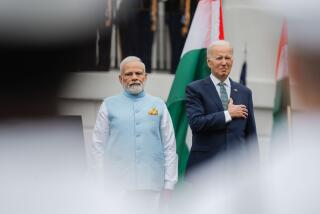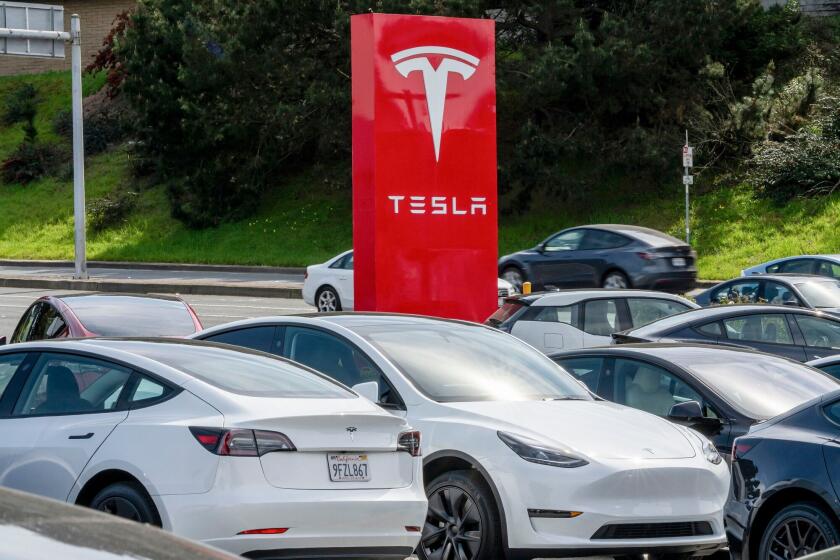U.S.-India Business Ventures Take Off
- Share via
BOMBAY, India — U.S. Commercial Consul John S. Wood has but one waistline to give for his country. And it’s being sorely tested.
“The place is so bloody busy I don’t know whether I’m coming or going,” Wood complained jovially one recent afternoon. “The number of people coming here is astounding.”
Indian-American trade has never been better, nor Wood’s appointment book fuller. That means plenty of working breakfasts, luncheons and dinners as U.S. executives call on India’s business capital and Wood serves as information source and matchmaker with Indian business people.
“I’ve been home for dinner once this week,” Wood groused good-naturedly. “I’ve had lunch at my desk once.”
As of Jan. 1, according to the gregarious Bombay-based envoy of the Commerce Department, there were 1,200 collaborations between American and Indian businesses.
That boom is a far cry from the time of rampant anti-American feelings here three years ago when Pepsi entered the Indian market--triggering, by one count, 5,000 hostile examples of press coverage as Indian bottlers and their political allies defended the home turf.
These days, far from telling the Yankees to go home, the typical Indian business leader is eagerly looking for a tie-in.
If you drive a new Chevrolet, Buick or other GM car in the United States, chances are its radiator cap was made by Madras-based Sundram Fasteners Ltd. At least 2.5 million caps have been shipped by Sundram, emboldening Indian manufacturers who think their quality plus low production costs will succeed in the $150-billion U.S. auto parts market.
“Where radiator caps go, other products will follow,” Sundram predicted in an advertisement.
The business prospects cover a range of fields. For instance, because of changes in world textile trade linked to the new General Agreement on Tariffs and Trade, India’s clothing exports to America are expected to rise. Sonia Kumar of New Delhi’s Silver Tulip, an upscale women’s fashion house, already supplies two stores in Los Angeles with her richly tailored versions of traditional Indian wear.
“They visit me once every two months, pick up a bunch of things, then sell it for four times the price,” Kumar said.
From agricultural products to computer services distributed via satellite, the export list is big and growing.
And for U.S. and other foreign multinationals, India holds the promise of a huge domestic market, a prospect dimmed only by horror stories of dealing with the Indian bureaucracy.
Take Kellogg Co. In mid-June, its plant on the outskirts of Bombay is supposed to begin production of Kellogg’s Corn Flakes and other cereals for sale in major metropolitan areas where a more traditional breakfast is bread and buttermilk.
“We think once they discover the great taste, convenience and nutritional value of Kellogg’s products, Indian consumers will have a strong interest in our cereals,” corporate publicity manager Anthony Hebron said in an interview. He refused to disclose how much Kellogg has invested, but Bombay financial circles estimate the project at $40 million to $50 million.
PepsiCo is bringing in its Taco Bell, Pizza Hut and Kentucky Fried Chicken divisions. McDonald’s plans to open in Bombay with a beef-free menu--a concession to religious sensibilities in a country where for hundreds of millions, the cow is holy.
A Detroit-based company and an Indian partner are building a glass plant in Gujarat. In the same western state, GM and Hindustan Motors plan to manufacture Opel Astras, with commercial production expected to begin next year.
In January, Morgan Stanley launched the first foreign mutual fund allowed into India and collected $300 million in investments, three times its projection.
General Electric is in India on many fronts. Its heavyweight finance division, GE Capital, has created a consumer credit company with India’s largest private-sector financial institution to handle purchases of TVs and refrigerators by Indian consumers.
“Americans are here by the load,” one Bombay journalist said. “People have come to feel around, to see what can be done.”
*
Not all of them are bullish on India. As elsewhere in Asia, the lack of intellectual property rights and patent protection particularly scares companies making drugs, chemicals, metals and other products based on secret recipes. It is the No. 1 irritant in U.S.-Indian commercial relations.
India’s government also got a low rating on being business-friendly from U.S. and Indian executives polled by Roper Starch Worldwide. More than two-thirds of the 201 people polled said the bureaucratic challenges of doing business in India were greater than in other developing countries.
In a list of 11 emerging economies rated by the polled executives for their business climate, India was ranked eighth. Mexico was the top vote-getter, and the Asian countries of China, Malaysia, Thailand, Indonesia and Vietnam--India’s rivals for foreign investment--all outpolled India.
Such reservations are issues that Prime Minister P. V. Narasimha Rao will have to address when he promotes greater U.S.-Indian trade in a visit to the United States this month.
Wood, who began coming to India more than 20 years ago as area director for Helene Curtis cosmetics, has heard all the negatives. The potential rewards are great, he says, but the American who wants to do business in India will need endurance.
“You can’t come to India and make a million bucks in a week,” Wood said. Since 1992, government barriers have been coming down, he stresses. But anybody who wants to do business in India, in Wood’s words, needs to be “a world-class hurdler with great patience.”
More to Read
Inside the business of entertainment
The Wide Shot brings you news, analysis and insights on everything from streaming wars to production — and what it all means for the future.
You may occasionally receive promotional content from the Los Angeles Times.










